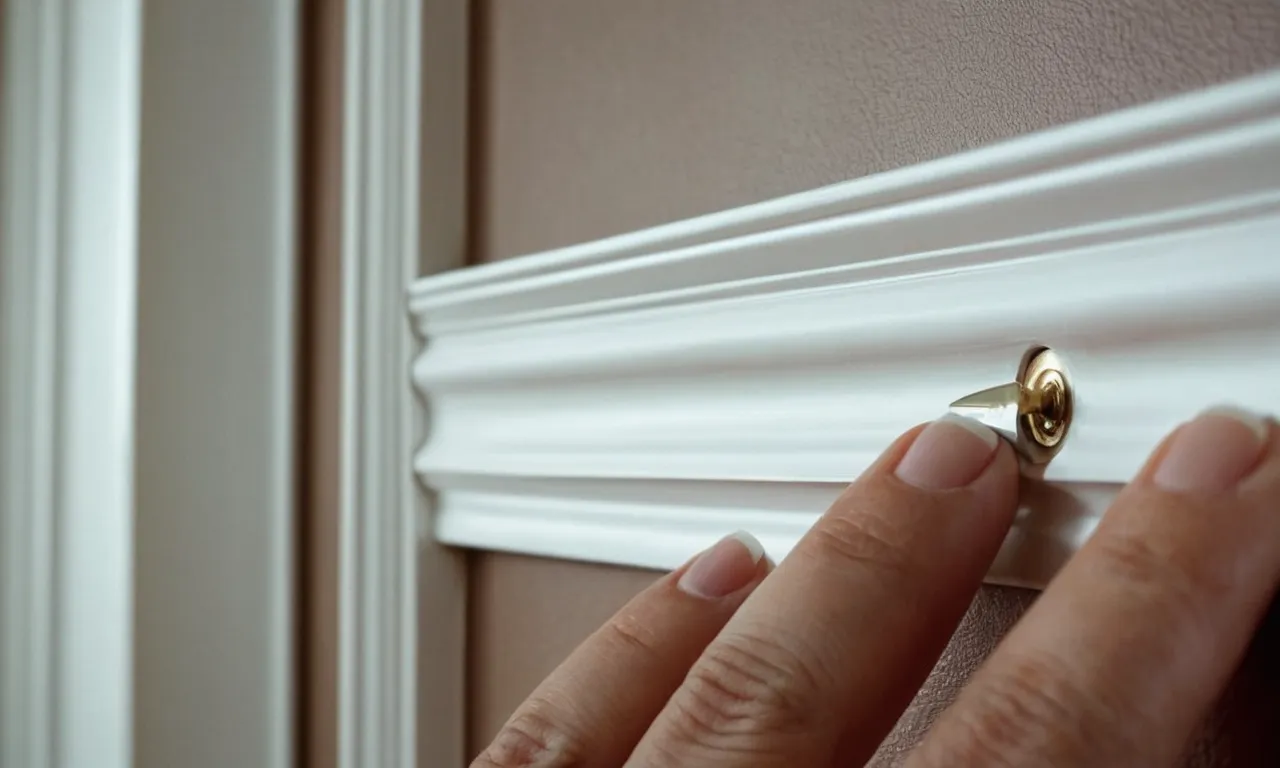How To Fill Nail Holes In Trim
If you just installed new trim or molding in your home, you may have noticed small nail holes left behind. While some people choose to leave them as-is, filling nail holes gives your trim a smooth, finished look.
If you’re wondering how to make those unsightly holes disappear, you’ve come to the right place.
If you’re short on time, here’s a quick answer to your question: Use spackling paste or wood filler to fill the holes, let it dry completely, then sand smooth and paint over the repairs for an invisible fix.
Assess the Holes
Count and measure the holes
The first step in filling nail holes is to thoroughly assess the damage. Carefully count each hole and use a tape measure or ruler to determine the width and depth of each one. Pay close attention to holes that are larger than average, as these may require more extensive filling.
As you measure, make note of the size and location of each hole on a sheet of paper so you have a handy reference for the repair work ahead.
Inspect the trim piece closely under good lighting conditions. Look for any cracks or splits in the wood that may need repair before you begin filling holes. Also check for dents or gouges near the nail holes that should be remedied.
Taking the time to fully evaluate the trim damage will ensure you address all issues for a seamless finished look.
Determine hole depth
The depth of the nail holes is a key factor in choosing the right filling material. Shallow holes less than 1/8 inch deep can be quickly filled with putty or wood filler. For deeper holes up to 1 inch, a filler formulated for the job, such as plastic wood, works better as it will fully adhere and stay in place.
Holes deeper than 1 inch may require extra steps like gluing in a wooden peg before filling. Carefully probe each hole with a toothpick to gauge the depth and whether the hole penetrates all the way through the trim.
Deeper holes open to the back side should be plugged first to give the filler material more structure to grip.
Once you have assessed the depth of each hole and any connecting cracks or gouges, you can determine the most suitable filler material and technique for a smooth, durable repair.
Choose the Right Filler
Spackling Paste
Spackling paste is a lightweight filler often used for small holes and cracks in drywall. It is easy to apply and sand, dries quickly, and can easily be painted over once dry. Spackling paste is best for holes less than 1 inch wide and scratches or dents in walls.
It comes premixed and ready to use straight from the container. Simply apply it with a putty knife, allow it to dry completely, then sand smooth before painting. Spackling is affordable, widely available, and suitable for most minor drywall repairs in a home.
Wood Filler
Wood filler, also called wood putty, is designed specifically for filling holes and cracks in wood trim and furniture. It is formulated to bond well to wood and can be stained or painted to blend in seamlessly once dry. There are two main types of wood filler:
- Water-based wood filler – This type is convenient and easy to use. It cleans up with water and dries fast. Best for small holes.
- Solvent-based wood filler – Denser and more durable. Best for large holes or rotted wood repair. Requires mineral spirits for cleanup.
Wood filler comes in different shades to match various wood tones. Apply it with a putty knife, allow to dry, then sand smooth before finishing. Wood filler is the optimal choice for filling nail holes and imperfections in woodwork.
2-Part Wood Filler
For large holes and extensive wood repairs, a 2-part wood filler is the strongest choice. It consists of a thicker base compound and a liquid hardening agent that are mixed together before use. The 2 parts chemically react to create an extremely durable, long-lasting filler that won’t shrink or crack over time.
2-part wood fillers can fill holes up to 1 inch deep. They require more effort to mix and apply than other fillers but provide superior strength and hold up better to wear and tear. Allow the mixture to fully cure before sanding and refinishing the wood surface.
Though more expensive, 2-part epoxy wood fillers are ideal for heavy duty wood repairs.
Fill the Holes
Load filler onto putty knife
The first step in filling nail holes is to load the filler onto a putty knife. Use a spackling paste designed for small repairs rather than a premixed vinyl compound, which dries too quickly for nail holes.
Scoop a small amount of spackle onto the putty knife using the built-in scoop or a putty knife. You’ll only need a little bit – about enough to cover the nail hole. Resist the urge to blob on too much spackling paste at first. It’s easier to add more if you need it than to clean up excess.
Press filler into holes
Next, press the spackling paste into each nail hole, using the putty knife. Apply light pressure and scrape off any excess. The goal is to neatly fill each hole without globs of spackle building up on the trim.
If some excess does accumulate outside the hole, let it dry slightly and then scrape it off cleanly with the putty knife. Once all holes are filled, use the knife to smooth over the patches for the most seamless appearance.
Let filler dry completely
Finally, allow the filler to dry thoroughly before sanding and painting. Refer to the spackle container for exact drying times, but expect at least 24 hours. Remember, it’s essential not to paint or sand patches before they have dried, or you may peel off the spackle accidentally.
An easy way to tell if spackling is dry enough is to gently press on it with your finger – there should be no indentation left behind.
Once drying is complete, lightly sand each patched hole to smooth the surface. Careful sanding ensures paint will glide on evenly for a professional look. According to Home Depot’s website, holes filled with spackle can last for years, but may eventually show slight sinking.
If this happens, just clean out the hole and repeat the filling process.
Sand and Finish
Sand filled holes smooth
After the filler has dried completely, it’s time to sand the area smooth. Use medium grit sandpaper (around 150-220 grit) and gently sand in a circular motion. You don’t need to sand aggressively, just enough to smooth out any ridges or imperfections left behind from filling the holes.
Make sure to regularly wipe away dust with a rag so you can see clearly how the sanding is progressing. Sand until the filler is flush and even with the surrounding trim. Pay special attention to the edges and blend the transition. The goal is to create an undetectable, seamless patch job.
Spot prime
Once sanded smooth, wipe the sanded areas with a tack cloth to remove any leftover dust particles. Then, using a small artist paintbrush, prime only the sanded areas that you filled and feather out about 1/2 inch beyond the patch job perimeter.
This “spot priming” helps the new paint stick properly so the patches don’t show through down the road. Allow the primer to dry completely before painting.
Paint
Now you’re ready for the final step – paint! For the best results, use a small trim paint brush and apply two thin coats of paint to the primed areas, allowing proper drying time between coats. Make sure your brush strokes blend evenly into the surrounding trim areas.
If you properly prepped the holes, applied high quality filler, sanded things smooth, spot primed, and painted carefully, your patches should be virtually invisible! No one will know there were ever any holes there at all. You saved yourself the headache of replacing trim unnecessarily. Nice job!
Conclusion
Filling nail holes may seem tedious, but with the right tools and materials, it’s an easy fix. Taking the time to fill holes results in trim that looks professionally installed. Use spackling paste or wood filler, let it dry completely, then sand and paint for seamless repairs.
With a little effort, you can give your trim a smooth, hole-free finish.







